The Bears and the Bees
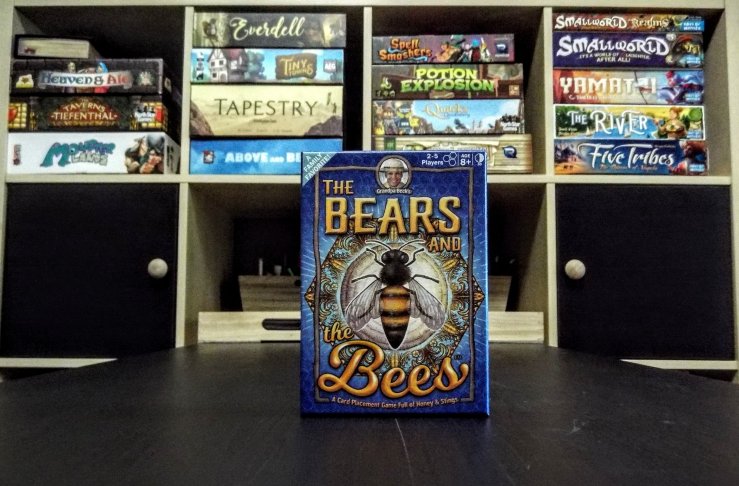
- Designer: Jeffery Beck
- Publisher: Grandpa Beck Games
- Players: 2-5
- Ages: 8+
- Time to play: 30 Minutes
Hey folks! Back again and this time with a review copy provided by Grandpa Beck’s Games. The Bears and the Bees. This is a game where we’re heading to the honey field! We’re looking for the least amount of stings, or points, and avoiding bears! This is a strategic tile laying game where the first player to run out of tiles earns no points. All other players earn points for tiles in their hands. Rinse and repeat for a total of three rounds. The player with the lowest score is the winner! So let’s suit up, tend to the hives, and see what’s in the box!
Components

- 70 Honeycomb Tiles
- 15 Worker Bee Tiles
- 10 Drone Tiles
- 5 Flower Tiles
- 3 Bear Tiles
- 1 Queen Bee Tile
Queen Bee Tile – The first tile to start the hive. All sides are honey, so any color can attach to it.

Honeycomb Tiles – These have two or three colors on each edge. They are the only ones that can touch the Queen Bee tile. These are worth 5 points each at the end of the round.

Drone Tiles – These are half honey and half colored and have a single bee on it. That makes it a little easier to place. The are worth 10 points each at the end of the round.
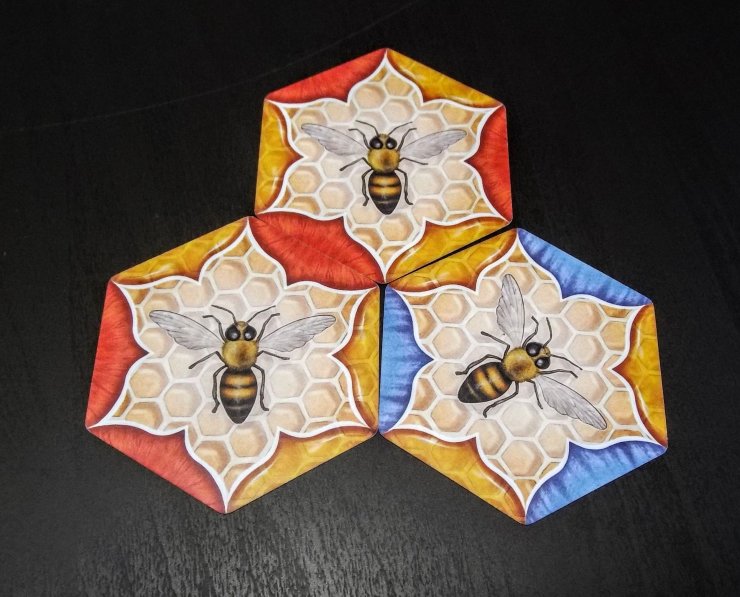
Worker Bee Tiles – These have one side of each color, one honey side, and three bees on it. After you play a worker bee tile, you force one other player to draw a card. These are worth 10 points at the end of the round.

Flower Tiles – These have the same color on all sides. These are tricky to play. After you play a flower card, all other players must draw a card. These are worth 10 points at the end of the round.

Bear Tiles – These can only connect to honey sides of other tiles. Why? Well, bears love honey. After playing a bear tile, you give one of your cards to another player. These are worth 15 points at the end of the game.
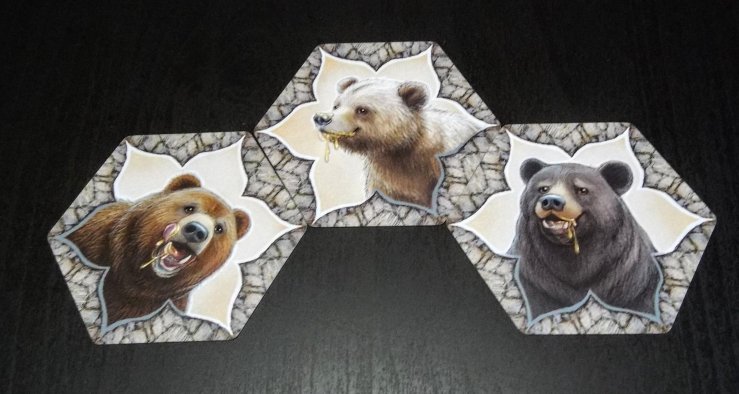
Set Up
- Place the Queen Tile in the center of the tile.
- Shuffle all the other tiles and deal a number to each player depending on player count.
- 9 cards for a 2-3 player game.
- 8 cards for a 4-5 player game.
- Flip the top card of the deck to attach to the Queen Bee til.
- Only Honeycomb tiles can attach to the Queen Bee tile. All other types of tiles are discard. Draw another card and attach it to the Queen Bee tile if the previous one isn’t a Honeycomb Tile.
Game Play
On a players turn, they must do one of the three actions.
- Play a tile.
- A played tile must connect to two other tiles.
- All sides must match colors or connect to a wild, or honey side.
- Only Honeycombs can attach to the Queen Bee tile.
- Bonus Play. If you add a tile and it connects to 3 or more other tiles, you can play another tile. These other tiles can chain other bonus plays.
- Draw a card from the deck.
- Discard a card, and draw two cards from the deck.
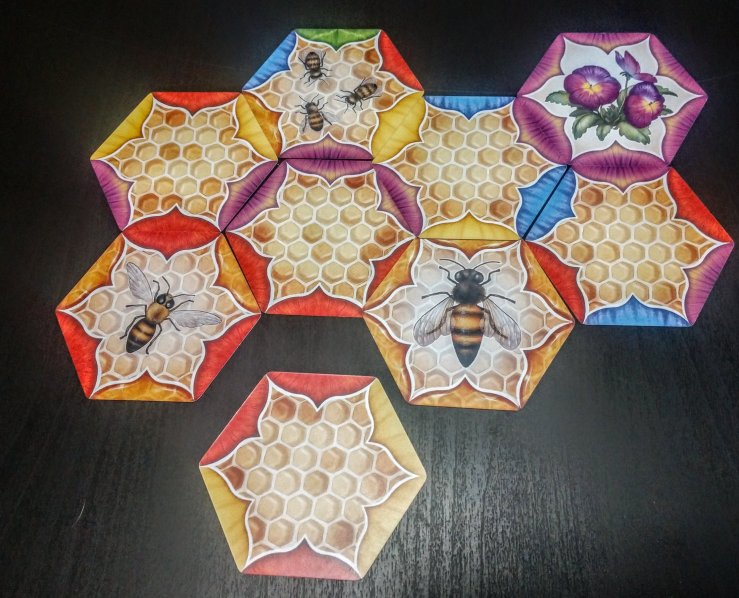
The first player to play their last tile from their hand wins the round. If you’re playing a short game, then they win they game! Yay!
If you’re playing the full game, you’ll tally points of the other players. Each tile in a players hand at the end of the game is worth points the points listed under components. Total these points, record them on a sheet of paper, then start the next round. Return all cards to the deck, reshuffle, then deal out a new hand of tiles. Play for a total of three rounds. Tally up each players scores. The player with the lowest score is the winner!
Advance Play
Added Bonuses
When you connect more than 3 tiles, you earn more bonus plays.
- 4 Tiles – 2 Extra Plays
- 5 Tiles – 3 Extra Plays
- 6 Tiles – Instant Winner!
Added Stings
When playing a flower or worker bee, the more than 2 tiles, you can force players to draw more than one tile.
- 2 Tiles – 1 Draw
- 3 Tiles – 2 Draw
- 4 Tiles – 3 Draws
- 5 Tiles – 4 Draws
- 6 Tiles – 5 Draws
Final Thoughts
I want to talk about the components. These are some nice cards used for the tiles. The art on them is nice. I like how the honey combs looks on the background of each card. The bees have nice detail and the bears look good. The flowers are nicely done. Overall, the art in the game is enjoyable. The one thing I found a little hard to differentiate was the color yellow and the honey. One of the ways to tell the difference is that the honey is transparent. In low lighting occasions, this is a little difficult to tell. The one other thing I had wished came with the game was a score sheet. While a regular sheet of paper would work, it’s always nice to see a custom sheet for a game.
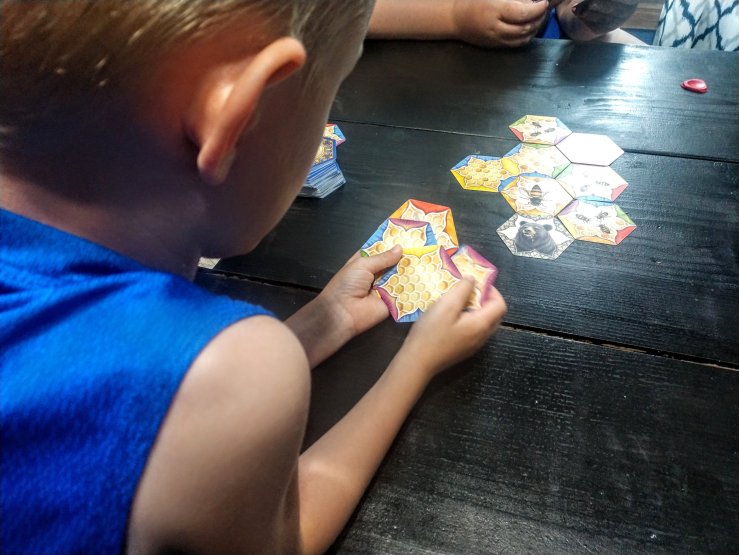
Game play is simple and easy. Now, to be honest the first couple of games I played I completely missed the part where only honeycomb tiles could attach to the queen bee. You’ll see some nice photos of the game I played. All against the rules in the rule book! Going forward I’ll make sure to point this out, but I don’t think that took away from the game any. To me, this plays similarly to Uno. It’s just an advanced Uno with tiles instead of cards. In that sense, it’s really easy to explain the game to anyone new to it. You’re matching colors and trying to get rid of the cards in your hand. You earn points based on whats left in your hand at the end of the round. I don’t think I lost anyone yet. I really like that the different special tiles are easy to tell apart. The worker and drone tiles not only have different amount of colors, they also have a different number of bees on the card. That’s a nice visual cue to what the card does.
I like that there are several ways to play the game. You can do a single round or play three rounds and keep score. Then on top of that, you can play with a rule set that rewards connecting to more tiles. I like that this was all thought out and you get a game on different levels. My son was able to play this game. He’s 5 years old. Now, he did need some assistance to find some matches, and a lot of the time we needed to draw his attention back to the game. I think teams with that young of kids would be the best, but it is something that helps with matching colors. There is just enough of take that in the game to make it competitive and fun to play. It’s not over the top, where you just feel mean about playing cards. That’s of course if no one is ganging up on a player. Now, I do feel bad that in several of the games I might have pointed out when a player is down to one card. Then, like how bees release a alarm pheromone, all other players focus their attention on that player. Ultra-focused on stopping them from getting rid of that last tile.
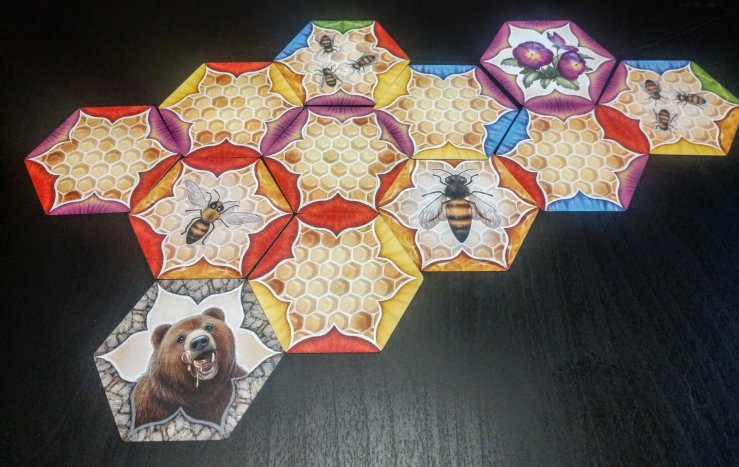
Over all, The Bears and the Bees is a fun family game. It’s easy to teach and play, fun with all ages, and has that familiar feel of another game. The bonus is it adds a nice puzzle and tile laying aspect to the game. I’m a big fan of tile laying games, and when I saw what this one was about, I just knew I had to try it. This one is going into my easy to transport, fun to play pile of games. I feel like this the perfect step up from the classic Uno and one that everyone would enjoy. It’s a nice way to intro people into the world of board games without jumping in the deep end.
